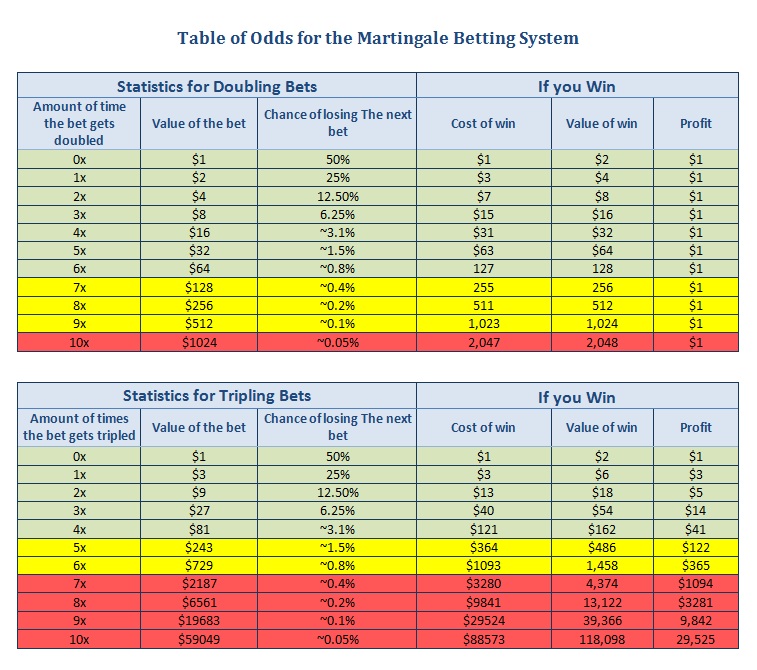The Martingale Betting System
The Martingale betting system dates back to at least the 18th century when gambling halls first gained popularity in Europe. It is most frequently applied to games like craps and roulette but can just as easily be applied to any game of chance. The reason that betting systems like the Martingale are not frequently used for skill-based games like blackjack and video poker is that there are real strategies that would be better employed to improve a player’s odds in those games. Furthermore, those games have betting maximums that would make it impossible to continue using the Martingale system in instances where players hit a long losing streak.
Beware
The Martingale system gives the player a high chance of winning a lot of small amounts and a low chance of losing a large amount, therefore typically users of the system will be better off in the short run. However be aware that it is inevitable that the player will eventually lose an amount so large that they go bust or hit the table limit and be unable to continue.
How does the Martingale betting system work?
The Martingale is probably the most popular betting system, not because of effectiveness, but because of simplicity. There are no complex equations to memorize here; anyone can quickly learn and use the Martingale system. The system works best on bets that have a near 50/50 chance of winning or losing, such as bets on the red or black of a roulette table. Players need only double their bet (or more) with every loss. For example, if a player wagers a minimum $1 bet on the black at the roulette table and subsequently loses, then according to the Martingale system’s rules they would then wager $2 on the next spin, again on the black and always staying on the black. If they lose again, then their next bet will be $4 and so on, doubling it after every loss. Then, when the player eventually wins they will recoup all of their losses plus a little more and their next bet will return to the original $1 to start the system again.
What is the logic behind the Martingale betting system?
At first glance, the Martingale betting system makes perfect sense. By doubling your bet (or more) after every loss, you ensure that when you do win you will win back all of your collective losses as well as a profit equal to your original bet. Returning to your original bet after every win also seems to limit your investment by keeping your wagers as low as possible. To step things up a bit and make the system pay off more quickly a player can recoup all of their losses plus a lot more if they decide to triple their bet after each loss instead of doubling it. Deciding to triple the bet after each loss must not be taken lightly though as it increases the risk exponentially as can be illustrated in the table of odds below. 
Why is the Martingale betting system flawed?
The Martingale system may sound too good to be true to newcomers but it is no path to easy money and those using the system are exposed to unlikely but high value risks for little reward. The system manipulates statistics so the player has a high chance of winning a lot of small amounts in exchange for a low risk of losing a lot. The problem is that if the system is used by a player for long enough it is inevitable that the player will eventually hit a losing streak, making a huge loss that will wipe out all of the cumulative small wins they made over a long period of time. According to the law of statistics there is approximately a 0.1% chance of losing a 50/50 bet more than nine times in a row but if a player uses the system for 1,000 bets then they are likely to see this outcome once and that could spell huge losses. The other thing is that most table games like roulette have minimum and maximum bets, which do not work well with the Martingale system as players are likely to hit the maximum table bet at some point.
Would the opposite of the Martingale betting system work?
Many players both consciously and unconsciously utilize what is known as an anti-Martingale betting system. That is, they try to take advantage of positive fluctuations in the odds by only increasing their bets when they’re winning and by only making the minimum bet when they are losing. This may seem safer, because you are only betting more when you have already made a profit, but unfortunately the end result is the same. If you keep doubling your bets as you win, then ultimately when you finally lose you lose everything you have accumulated plus any minimum bets made between wins.
Martingale Betting and “Sticky” Bonuses
The Martingale System does work very well when wagering with non-withdrawable bonuses. It is not uncommon to find situations where you can deposit £100 and get as much as £400 in non withdrawable money that you can wager with. Some casinos have maximum win rates from these deposits which can reduce the benefits of playing games such as slots or video poker as you do not get to fully benefit from your winnings. Instead of playing the full Martingale system you can start with small bet sizes of whatever game you are playing and then if you have lost some of the money and keep increasing the size of your bets (but not depositing again) until you have either busted your deposit and bonus money or made a profit.
Have you used the Martingale system?
Have you ever used the Martingale system and what was the outcome? We would love to hear your experiences and thoughts in the comments below.
